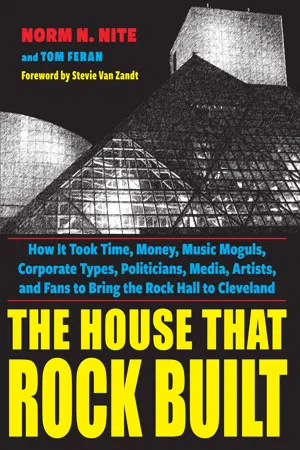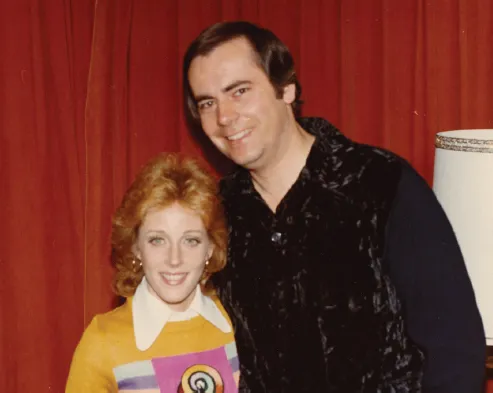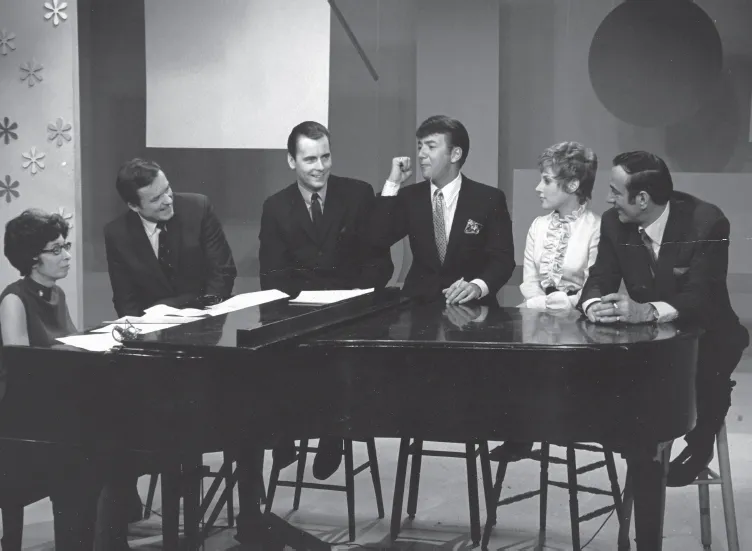Lesley Gore and Norm N. Nite in October 1972 (Courtesy of Robert Goluski)
She attended college, kept recording and performing, and, as Cat-woman’s sidekick Pussycat, even introduced her song “California Nights” on an episode of ABC’s Batman in 1967.
It was to be Lesley’s last top 20 record. After five years, the hits stopped coming. It happened to a lot of artists. By 1983, at age 37, she was a nostalgia act, the answer to a trivia question, but still a talented and ambitious dynamo writing songs and performing. She was a wonderful person.
We had been friends for many years. We first met on the nationally syndicated Mike Douglas Show in January 1968, during a week when Bobby Darin was the cohost, when the topic was the roots of rock and roll.
Early rock and roll was my passion. It had been the world-changing, mood-making soundtrack of my life growing up in Cleveland’s Tremont neighborhood, which was the uncredited setting for the movie A Christmas Story. I built a huge record collection and listened to guys on the radio like Alan Freed, Tommy Edwards, Bill Randle, Jockey John Slade, and Pete “Mad Daddy” Myers. When I got to Ohio University, I switched my major from business to broadcasting, went on the air at the campus station, and produced a tape-recorded thesis that I later expanded into a narrative album, Rock and Roll—Evolution or Revolution?
The album, issued on Laurie Records in 1967, was the first recorded history of rock and roll. To make it, I had to track down 41 artists whose songs I sampled for interviews and permissions, from the Crows—whose “Gee” charted in 1954—to the Music Explosion—whose “Little Bit O’ Soul” went gold in 1967. Some of the artists were still performing. Others worked in various trades. About a dozen were penniless.
That’s rock and roll. When the album put me on The Mike Douglas Show, I was fresh out of the army and selling cars. But the passion for music soon put me on Cleveland’s WHK and WGAR with my Nite Train oldies show and then in 1973 brought me to WCBS-FM in New York. My research for the album would later become the foundation for my Rock On encyclopedia series of books and for the one-hour radio specials I called “rockumentaries.”
Moving from Cleveland to New York put me closer to a lot of the performers I’d come to know. Many became regular listeners and guests. Lesley was a favorite. I would call her up to put her on my show, and we both enjoyed it. Jay Black, of Jay and the Americans, once kidded me on the air by loudly demanding that I tell him Lesley’s shoe size. I was known as “Mr. Music” by then, and I reinforced my reputation as a serious historian on rock when the first Rock On book came out in 1974.
When Lesley called me out of the clear blue sky on August 2, 1983, she said, “Listen, some people are talking about doing a Rock and Roll Hall of Fame, and we’re going to have a meeting, and because you’re a music authority we’d like you to be at that meeting.”
The Mike Douglas Show, January 22, 1968. Left to right: Ellie Frankel, Mike Douglas, Norm. N. Nite, Bobby Darin, Lesley Gore, and Guy Marks. (Author’s collection)
I agreed to go. The meeting, on August 10, was in a loft apartment on East 28th Street in Manhattan. Lesley wasn’t there. I looked around and saw someone from Radio City, someone from Billboard, and a guy who was a singer with the Dovells. They had big ideas, but they were lightweights in the music industry.
There was also a smart young lawyer named Suzan Evans, who was involved with a group called the Black Tie Network. She said she was there so we could put together something called “The Rock and Roll Hall of Fame with the Black Tie Network” for a TV special on its induction ceremonies. It would be comparable to Dick Clark’s American Music Awards shows.
We had several other meetings, and then I decided not to go to any more because I didn’t think anything was going to happen, not sitting around talking with this group. My impression was that there was no one who was a mover and shaker. I was not going to be involved.
Suzan didn’t come after the first meeting. I told her afterward that I thought the other people were lightweights and that it seemed nothing was going to happen. I wondered if she was sounding me out and had reached the same conclusion. She didn’t tell me anything else was going on.
Unbeknownst to me, it was.
Alan Freed would go on to wider fame, but it was his Cleveland contemporary Bill Randle whom Time magazine proclaimed America’s “top jock” disc jockey in 1955. As cool as Freed was hot, he came to Cleveland’s WERE in 1949 from his native Detroit. He demonstrated an uncanny ability to pick hits and new artists—Time said he did it better than anyone else in the country—and pioneered music research, making Cleveland the era’s “breakout” market for new records. He had an incredible 54 percent share of the radio audience tuned to his daily show on WERE by the mid-1950s, and he commuted on weekends to a show on WCBS in New York.
He booked and emceed Elvis Presley’s first appearance in a pop music show in suburban Brooklyn, Ohio, and helped launch and build the careers of Elvis, Tony Bennett, Johnnie Ray, Sam Cooke, Fats Domino, the Diamonds, the Crew-Cuts, Bobby Darin, and Rosemary Clooney, among others. It was Randle who introduced Elvis on his first national TV appearance in 1956 and whom Ralph Kramden and Ed Norton wanted to play the song they’d written on an episode of The Honeymooners.
A high school dropout who earned eight degrees, wrote books, worked as a lawyer and college professor, raced cars, and flew planes, he walked away from radio in 1961 and said he went back to WCBS a year later for fun “and for money” while teaching at Columbia. He returned to Cleveland and WERE in 1965. He told Billboard, “Somebody said, ‘Why are you leaving the Big Time?’ I said, ‘Cleveland is the Big Time. There’ve been only three or four personalities who’ve really had impact in the nation and none of them have been from New York.’”
He died in Cleveland at 81 in July 2004.
As she explained it later, the woman who would become Suzan Evans Hochberg was a New Yorker who got into the entertainment business because she was miserable practicing law. A graduate of Boston University and Brooklyn Law School, she had been working in the profession for about 18 months when she had dinner with a friend, a woman who was also an attorney, and said she was thinking of taking time off to consider another direction.
AHMET ERTEGUN WAS ALMOST INVARIABLY DESCRIBED AS ROYALTY IN THE MUSIC INDUSTRY.
It was a fortuitous conversation. The friend represented the Black Tie Network, a television production company interested in building a pay-per-view business, and represented an independent producer, Bruce Brandwen. He had the idea of creating an entity called the Rock and Roll Hall of Fame, so he could use it to produce an awards ceremony and concert for pay-per-view television.
Suzan recalled, “He needed somebody to make it happen. One of the people who worked with him on his team was a cousin of Lesley Gore. He had talked her into using her name as a proponent of this Rock and Roll Hall of Fame. And he also retained a lawyer from Los Angeles who was well known in the music industry, David Braun.
“It sounded like an interesting idea and a challenging project,” she said. So Evans quit her job, left the law, became executive director at a sizable pay cut, moved into an office with Black Tie, and did the legal work of incorporating the company. The group next planned to form a board of directors and a nominating committee, come up with rules for nomination, “and figure out a way to give it some gravitas,” she said. “This was all an idea so there would be an entity called the Rock and Roll Hall of Fame and this producer could produce a concert for payper-view.”
Braun introduced them to leaders in the music industry to pitch the concept. One of these was Ahmet Ertegun, with whom Evans would meet many times, trying to convince him that he should be chairman of this Hall of Fame.
Ertegun was an inspired and ambitious choice. The cofounder and president of Atlantic Records, he had been a producer and songwriter whose eclectic taste and ear for talent had helped shape American pop music since the 1950s. His mastery of relationships, in a business built on them, created the presence that had led the New Yorker to call him “the Greatest Rock-and-Roll Mogul in the World.”
Respected even by rivals, he was almost invariably described as royalty in the music industry, and with good reason. Born in Turkey of aristocratic heritage, at age 12 he moved with his family to Washington, DC, when his father, Munir, was appointed ambassador to the United States for the Turkish Republic. (They lived in a mansion, later to become the Turkish embassy, that was built during the Gilded Age by a millionaire businessman from Cleveland, Edward Hamlin Everett.)
In the often dodgy record business, Ahmet Ertegun was literally like royalty. Born in Turkey to an aristocratic family, he had developed his taste for jazz and rhythm and blues in Washington, DC, where he moved at age 12 when his father was named ambassador to the United States.
He cofounded Atlantic Records, building it to the nation’s premier R&B label while producing or coproducing most of its releases. After he was approached to join the advisory board of the Rock and Roll Hall of Fame pay-per-view event, Suzan Evans Hochberg recalled that he said, “If it’s going to be a nonprofit, it should be nonprofit and not an excuse to produce a television show.”
Ertegun recruited a group of industry leaders and established the Rock and Roll Hall of Fame Foundation with himself as chairman. The memory of his early years plugging records on the road would open him to hearing Cleveland’s bid to establish a significant bricks-and-mortar structure, and his interest in Turkish politics would reinforce it.
He was inducted into the Hall of Fame in 1987, and the museum’s main exhibition hall was named for him in 1995. He died in 2006 at age 83.
Washington helped nurture Ahmet’s lifelong interest in politics and policy, especially involving Turkey. He and his older brother, Nesuhi, explored the segregated city’s neighborhoods, becoming devoted regulars in its jazz clubs and record stores. Their father opened the embassy to African American musicians they invited to brunches. The brothers staged jazz concerts, growing in the passion that led them both to the record business.
Cultivated, complex, impeccably dressed, and gentlemanly, Ertegun was, as biographer Robert Greenfield described him, “a creature of his own creation.”
Now he was interested in the Rock and Roll Hall of Fame.
“He kept requesting to meet with me to talk about it and throw ideas around,” Suzan recalled. “He called one day and said, ‘I think I’ll be very interested to do this and become chairman and grow this thing. But if this is going to be an institution which is going to be respected by artists and by the industry, and if I’m going to donate my time and do this as a charity, I just don’t like the idea that the reason for this institution is so that some producer could produce a TV show and make money from it. It doesn’t sit right with me. If it’s going to be a nonprofit, it should be nonprofit and not an excuse to produce a television show.’ So with that, he and I kept meeting. He kept saying, ‘It’s going to be a respected institution, we have to have the music industry participate, and these are the people I think we should approach to be on the board and on the nominating committee.’
“Ahmet put together a board made up of leaders in the music industry. He said, ‘We need to have that kid who runs Sire Records.’ He gave me the kid’s name and numbers.” She laughed at the memory. The kid was Seymour Stein, who was becoming a legend for putting Sire at the vanguard of new wave rock.
“I walked into Seymour Stein’s office,” Suzan said, “and there was Madonna on the telephone in her black bra. This is 1983. I saw ‘the kid,’ Seymour, sitting behind his desk, and at that time he was probably 41 years old. To Ahmet, who was almost 60, he was a kid.”
“Ahmet called me, and I was very excited,” Stein said. “Ahmet was one of my heroes. I knew him fairly well, but this would really bring us very, very close together.”
They also reached out to Allen Grubman, who was considered the most important entertainment lawyer in the music industry. His clients and contacts ran deep among both talent an...



